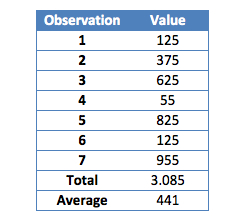Do We Need Business Intelligence in Sales?
 In this post on the issue of applying business intelligence on the sales process we will look at two of the most fundamental numbers.
In this post on the issue of applying business intelligence on the sales process we will look at two of the most fundamental numbers.
- The average order size
- The average length of the sales cycle (in minutes, hours, days, weeks or months)
The concept of “average” seems to be difficult to grasp for many sales executives.
The definition of an average is: “The result obtained by adding several quantities together and then dividing this total by the number of quantities.”
In business we continuously operate with numbers based on considering the average of something. Despite the precise definition of the concept of the average we often get the following types of answers when probing for key numbers from the sales process.
Question: “What is the average order size with new customers?”
Answer: “That differs a lot. It can be anything from 250.000 to several millions. From time to time we have orders of a two digit magnitude”
Question: “What is the average sales cycle in months?”
Answer: “That also differs a lot. It obviously depends on when we consider the sale process starting and ending. Some projects, especially the big ones always starts with a small pilot before we get the full project. I would say between 1 and 9 months. In some cases however it does take over a year”
Question: “What is the average gross margin on your first-time orders?”
Answer: “Hard to say. We don’t keep track of sales resources. Pre-sales do register their time, but often we don’t allocate the effort to the individual project until we have an order.”
We have several issues in the example above:
- Fluffy definition of both the sales process and the order size
- Lack of process management and monitoring
Calculating averages or key numbers requires definitions and tracking, but it also requires an understanding of what we will use them for.
Business Intelligence in Sales
Most companies have their manufacturing and logistics processes well documented and under constant monitoring. Their executives are constantly optimizing the processes. Also the internal administration processes are being managed tightly.
However, sales somehow always seem to escape being scrutinized.

sales somehow always seem to escape being scrutinized
The sales cost – in companies where you need sales people on the street to identify potential customers, activate their needs for your product and manage the customer’s purchase process – may well amount to 20% of your gross margin. In the software industry that typically corresponds to 20% of your revenue! Is there anywhere else in your company where an improvement of 10% will have larger impact on you profit line?
Let’s assume that your average order size is € 250.000 and the average length of your sales cycle is 14 months. What is the impact of reducing the sales cycle by two months? How can this be accomplished?
Let’s assume that you start monitoring how many resources you are using on which sale activities. It turns out that you spend on average 50% of all sales and pre-sales time on non-customer related activities. Of the remaining 50% you are on average using 75% of sales and pre-sales time on cases you loose. You are effectively using 12.5% of sales time on cases you win. Is there someway to optimize these numbers?
Applying business intelligence principles in sales certainly makes sense. It will meet with resistance, but I don’t see how you can scale your business fast unless you get this area under control.
Scaling internationally
I am writing this post, because of the impact the above mentioned issues are having on scaling internationally.
 Let’s assume that you want to move into a new market. You can do so by setting up a subsidiary and hiring your own people. You can assign a sales agent to get you bootstrapped and establish the bridgehead later. You can assign partners to resell your product. There are many more ways to enter a new market, but in all situations you will have to explain your business model and answer some fundamental questions concerning the sales process.
Let’s assume that you want to move into a new market. You can do so by setting up a subsidiary and hiring your own people. You can assign a sales agent to get you bootstrapped and establish the bridgehead later. You can assign partners to resell your product. There are many more ways to enter a new market, but in all situations you will have to explain your business model and answer some fundamental questions concerning the sales process.
Imagine that the only answers you can provide are those listed in the quote box above. How are your future sales people and/or business partners going to plan the activities and allocate the funds required to get the business going and reach profitability?
Am I right that the sales department somehow still manage to escape the business intelligence x-ray? If so, why? Sales is such an expensive part of the business model. Shouldn’t it be the first place to optimize?








